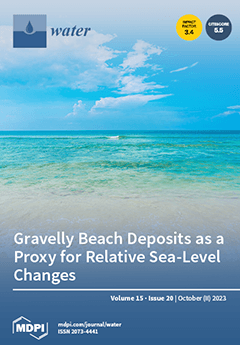The modification of pristine biochar derived from the waste of sweet prickly pear using the green modification method to produce nano-sized biochar (nanobiochar) for the removal of steroidal hormones and heavy metals from water and wastewater is reported in this study. Based on the characterisation results using FTIR, Raman spectroscopy, and XPS, the material had (COOH), (C=O), and (OH) functional groups typical of graphitic amorphous carbon. The SEM-EDS and XRD results showed that the material was mesoporous and amorphous in nature. The BET analysis results revealed that the surface area significantly increased from 220.1 m
2/g to 354.6 m
2/g after the modification of the pristine biochar. Based on the TGA-DSC results, the material was thermally stable up to 550 °C. A complete factorial experimental design using Minitab 21 Statistical Software (version 18.1) was employed to optimise the experimental adsorption conditions. The F-values and
p-values for the lack-of-fit of the model showed the acceptability and significance of the ANOVA model. The Freundlich adsorption isotherm was found to provide a better fit for the steroid adsorption data than the Langmuir adsorption isotherm, with moderate values of R
2 ≥ 0.92 for Langmuir and R
2 ≥ 0.95 for Freundlich, as well as maximum adsorption capacities of 14.53 mg/g, 10.58 mg/g, 12.50 mg/g, 5.73 mg/g, 5.63 mg/g, and 9.75 mg/g obtained for estriol, α-oestradiol, β-oestradiol, testosterone, progesterone, and bisphenol A. Freundlich R
2 values were lower than Langmuir R
2 values for metal adsorption, with maximum adsorption capacities of 8.58 mg/g, 4.15 mg/g, and 6.95 mg/g obtained for nickel, cadmium, and lead, respectively. The maximum percentage of removal for effluents and influents was between 84–89% and 78–86% for steroid hormones and heavy metals, respectively. The highest removal percentage between 90–95% was obtained for spiked ultrapure water for both steroid hormones and heavy metals. The material exhibited a removal percentage up to 60% after the first four cycles.
Full article





